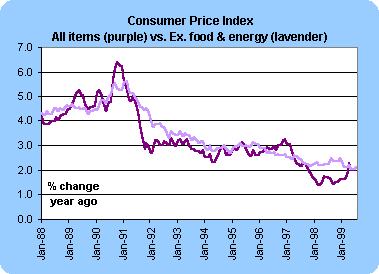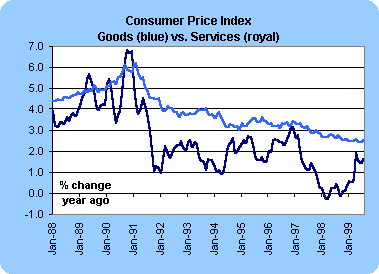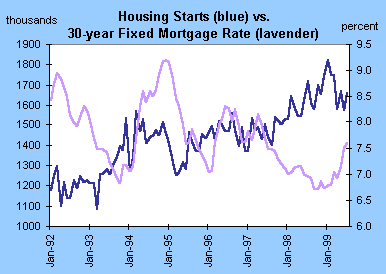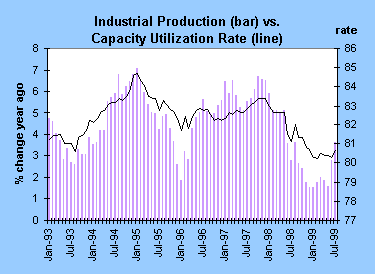Simply Economics August 20, 1999
By Evelina M. Tainer, Chief Economist &
Anne D. Picker, International Economist
Econoday
More input for the FOMC
Equity prices finish week on a positive note
Equities finished the week on a positive note with all indices participating. However, the S&P, Russell and NASDAQ continued to under perform relative to the Dow. Trading was slower than average as it has been for the past week, with many investors on vacation and others unwilling to buy or sell before Tuesday, when Federal Reserve policy-makers are expected to raise short-term rates. The anticipated 25 basis point increase has already been factored into the markets. Stocks also got a lift today as the dollar steadied against foreign currencies, helping to calm fears that investors are pulling money out of U.S. assets in search of higher returns in overseas markets.
Treasuries await Tuesday's interest rate decision
Bonds rose on optimism that next week's expected interest rate hike may be the last of the year. Helping bonds this week was a benign consumer price report on Tuesday, which eased concerns that the Fed will need to carry out a series of rate increases. The dollar, which stabilized today also helped lift bond prices, pushing down yields of 30-year Treasuries to below 6.00 percent.
|
Markets at a Glance |
| Treasury Securities | 12/31/98 | August 13 | August 20 | Weekly
Change |
|
30 year Bond | 5.09% | 6.10% | 5.98% | - 12 BP |
|
10 year Note | 4.65% | 5.97% | 5.87% | - 10 BP |
|
5 year Note | 4.53% | 5.87% | 5.77% | - 10 BP |
|
2 year Note | 4.53% | 5.70% | 5.62% | - 8 BP |
| Stock Prices |
|
Dow Jones Industrial Average | 9181* | 10974* | 11101* | + 1.2 % |
|
S&P 500 | 1229* | 1328* | 1337* | + 0.7 % |
|
NASDAQ Composite | 2193* | 2638* | 2648* | + 0.4 % |
|
Russell 2000 | 422* | 434* | 434* | + 0.0 % |
| Exchange Rates |
|
Euro/$ | 1.1668 | 1.0564 | 1.0669 | + 1.0 % |
|
Yen/$ | 113.20 | 115.75 | 111.39 | - 3.8 % |
| Commodity Prices |
|
Crude Oil ($/barrel) | $12.05 | $21.67 | $21.88 | + 1.0 % |
|
Gold | $289.20 | $263.20 | $259.60 | - 1.4 % |
| (* rounded) - (BP = basis points; stock price indices are rounded) |
|
Consumer price index rises in line with expectations
The consumer price index increased 0.3 percent in July, in line with expectations. Energy prices jumped 2.1 percent for the month after decreasing in the previous two months. Food prices showed more restraint with a modest 0.2 percent hike. Excluding the volatile food and energy components, the CPI rose 0.2 percent in July - also in line with expectations. We don't like to encourage the special factor syndrome (where the removal of special factors "clearly" indicates that inflation was nonexistent), but the major part of the rise was due to a spurt in tobacco and airline fares.

Market players were encouraged by the inflation news. They had feared that the report would show a worse picture. This set of news suggests to market participants that the Fed will likely raise rates at this month's FOMC meeting, but they may not necessarily raise rates at subsequent meetings this year.

The bottom line on the CPI report? The trends in the two charts above, which depict the major categories of the CPI, suggest that the best inflation news is probably behind us. Yet, no clear trends emerge that point to an upward spiral in inflation in upcoming months. The Fed intends to be preemptive in their policy decisions, but can't make a case for excessive force at this time.
Housing market is still robust
Housing starts jumped 5.7 percent in July to a 1.661 million unit rate. Gains were reported in the construction of single and multi-family homes. On a regional basis, starts rose in all areas of the country but the Midwest, where starts dropped 16.8 percent. Despite the gain from the previous month, starts are now 3.4 percent below year ago levels - with the declines concentrated in the multi-family sector.

Housing construction has been booming in the Midwest. It is likely that the decline from the previous month was due to shortages in key housing materials like gypsum. Other regions of the country may soon find declines in housing activity as well. The Beige Book had reported shortages in other regions also.
The bottom line on housing starts? The level of housing activity may not reassure Fed officials - they would surely like to see some moderation coming in this sector. Mortgage rates have picked up in the past few months and this tends to curtail housing activity with a slight lag. We probably have seen the peak in the housing market. The lower level of housing activity will eventually lead to a decrease in demand for consumer durable goods such as furniture and appliances.
Industrial production spurts after anemic first half
Industrial production increased 0.7 percent in July after more modest gains in the past few months. Increases were recorded in all industry groups (manufacturing, mining and utilities) and across all major market groups (consumer goods, business equipment, construction supplies, and materials). The production of motor vehicles, which had recorded healthy gains in the second quarter, started the third quarter on a much softer note - dropping 6 percent from June levels.

The bottom line on production? One month doesn't make a trend, but the chart above does show that industrial production is beginning to post some gains on a year over year basis after more anemic activity earlier in the year. This could cause some worries among Fed officials about excessive growth, but the manufacturing sector has been the weak link in the robust U.S. economy in the early part of this year.
More red ink from the global sector
The international trade deficit on goods and services deteriorated sharply in June with a $24.6 billion shortfall. This was more than expected by market players -- and a larger deficit than anticipated by the Bureau of Economic Analysis when they put together their initial forecast for real GDP in the second quarter. This will point to a downward revision in real GDP growth for the second quarter.

While the chart above depicts a slight upward trend in exports, import demand is far stronger. In June, much of the import growth was concentrated in capital equipment and industrial supplies. This is usually viewed more favorably than imports of consumer goods, which don't have the ability to expand the productive capacity of the U.S.
The bottom line on the trade figures? A deteriorating trade deficit is usually bad for the foreign exchange value of the dollar. This actually would help export demand in the future, because a weaker dollar eventually makes U.S. goods less expensive and more palatable to foreigners. In the meantime, this will hold down U.S. growth, which will alleviate Fed fears of excessive growth.
THE BOTTOM LINE
Economic news was generally favorable this past week. Production was robust, and this could worry Fed officials. Yet, they realize that rising rates take more than a month to filter through into dampened demand. Inflation news remains quiet, after accounting for the spurt in energy prices. The deteriorating trade deficit is bad news for the FX value of the dollar, but it does hamper U.S. growth, which could alleviate some Fed fears.
Fed officials will probably vote unanimously to raise the federal funds rate target by 25 basis points to 5.25 percent at the August 24 FOMC meeting. This is the expectation among the majority of participants in the financial markets. As they did last time, the Fed will probably return to a neutral bias, even after announcing the rate hike, as is standard operating procedure. At this time, it is too soon to tell whether the Fed will raise the fed funds target again later this year. If economic growth abates, then the likelihood of a rising rate environment diminishes.
Looking Ahead: Week of August 23 to 27
Few key economic indicators will be reported this week. We use the Market News Service survey of forecasts to describe the market consensus.
Tuesday
The Federal Open Market Committee (FOMC) is meeting today. The market consensus calls for a hike in the federal funds rate of 25 basis points, which would bring the fed funds rate to 5.25 percent.
Wednesday
Market players are looking for a 0.8 percent increase in new orders for durable goods in July. This follows a modest 0.4 percent rise in June. It reflects rebounds in machinery and in transportation orders, which includes motor vehicles and civilian aircraft.
Economists are predicting that existing single-family home sales will drop 4.3 percent in July to a 5.29 million unit rate. Sales had surged to new highs in June. The July moderation is not yet reflecting the higher mortgage rates which will likely curtail housing activity in coming months.
Thursday
Market participants are expecting new jobless claims to rise 3,000 in the week ended August 21 from last week's 284,000. The number of economists predicting this indicator has diminished rapidly these past couple of months as its volatility has increased.
The market consensus is looking for a downward revision to second quarter real GDP growth. The advance estimate showed that real GDP expanded at a 2.3 percent rate, but estimates now show that growth rose at a more moderate 1.8 percent rate. Economists expect that the price deflator remained unchanged, increasing at a 1.6 percent rate.
Friday
Economists are predicting personal income will rise 0.5 percent in July, less than the 0.7 percent hike recorded in June. At the same time, personal consumption expenditures should rise 0.4 percent for the month, slightly more than the 0.3 percent gain posted in June. This incorporates the retail sales figures already reported for the month.
|






